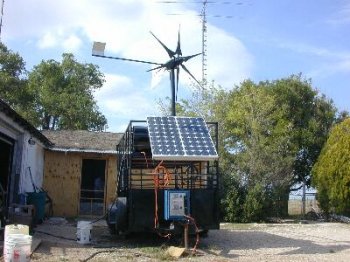
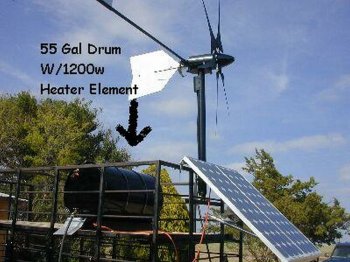
*Portable Solar & Wind System*
This article is the result of an alternative energy system I built and made to be portable. By using modular assemblies, this system can be transported and set up very easily and its feasibility was shown at the 2003 I.C. The system consists of four major components. They are the battery box, solar panels, a wind generator and the charge controller/inverter box.


The heart of this system is the charge controller/inverter box. The weatherproof enclosure contains the two pieces of equipment that are most important to a usable power system. The charge controller I used is a Trace C-40 model. I chose this unit for two reasons, Quality and Versatility. The C-40 has a very good track record for years of dependable service with very little maintenance requirements. It is also has multiple DC voltage inputs, 12, 24 or 48 volts with up to 40 amps of current through it and can be set to one of three control modes, charge control, load control or load diversion. For this system I have it set up for 12-volt input and diversion mode to use the excess generated power to heat water. By using diversion mode, it also insures a constant load on the wind generator to prevent over spinning the blades on it. The Tripp-Lite 1800-watt modified sine wave inverter provides three outlets of 110 volt AC output power. It has large input connection lugs that can handle wire sizes up to #02 welding cable from the batteries. Using larger wire lets the inverter work at its full output rating without overloading the circuits inside. It also has two temperature controlled cooling fans to increase its reliability. Another feature of this inverter is a low voltage shut down that will prevent discharging the batteries completely.
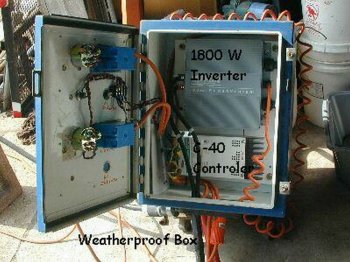
I built the small circuit board at the end of the C-40 to tie the wind and solar inputs together along with blocking diodes on it to prevent back feeding DC voltage to and between the wind generator and solar panels.
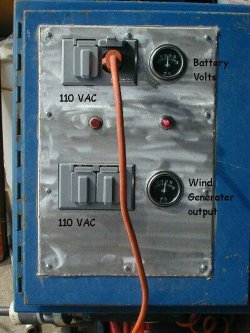
All of the component connections into the control box are twist lock type plug and sockets. This ensures good contact and reliable power transmission between the various components of the system. They also make deployment of the system very quick. This system can be set up and producing electricity in less then 30 minutes and taken down and moved just as fast.
The next component is the wind generator. This is not a commercially built wind generator and will be another article by itself with more details about it. But briefly it is a permanent magnet DC motor driven by wind to generate DC voltage. It adds to the versatility of this system by generating power after dark (provided the wind is blowing) when the solar panels quit producing power. This unit generates a power output equal to one of the solar panels used in this system.
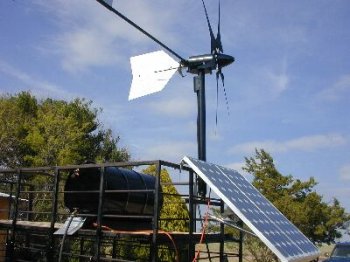
Along with the wind generator I used two Siemens SP-75 solar panels. These panels together produce a maximum output of 150 watts and 8+ amps of DC voltage to charge the batteries. The average output is 12 to 15 volts in full sunlight. The frame they are attached to has two hinged hangers with thumbscrews at the top and an adjustable support rod on the back the set the angle to maximize their output. They can be set up on the edge of a structure or railing or set up on the ground.
The last component of the system is the battery box. The military surplus footlocker worked great for this application. Inside the box are four deep cycle marine batteries that have a combined reserve capacity of 600 amp hours of power to feed the inverter. They sit inside two 1 1/2" aluminum angles to help support the weight of the batteries and from moving around on the floor of the box. Also inside at the end of the box is a 70-amp circuit breaker to protect the batteries if the outside connection points should be accidentally shorted together. Around the bottom of the box are four 2"dia. soffit vents to prevent explosive gases from being trapped inside the box. The connection points through the box are welding cable connects that can be found at any welding supply and major auto parts stores.
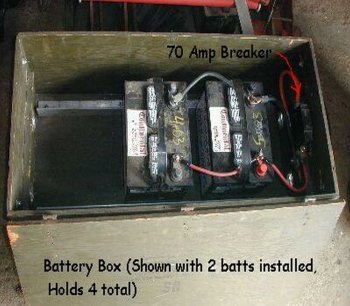
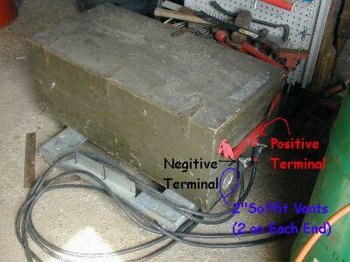
By making this system portable it can be used in a variety of situations from campouts to emergency power supply when the grid system fails. The total cost of this system was around $1200.00
MacGuyver
www.alpharubicon.com
All materials at this site not otherwise credited are Copyright © 1996 - 2004 Trip Williams. All rights reserved. May be reproduced for personal use only. Use of any material contained herein is subject to stated terms or written permission.